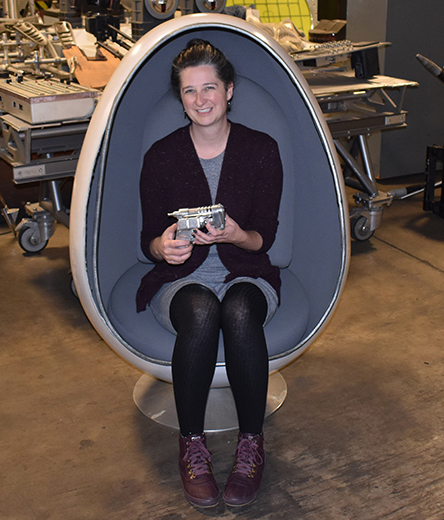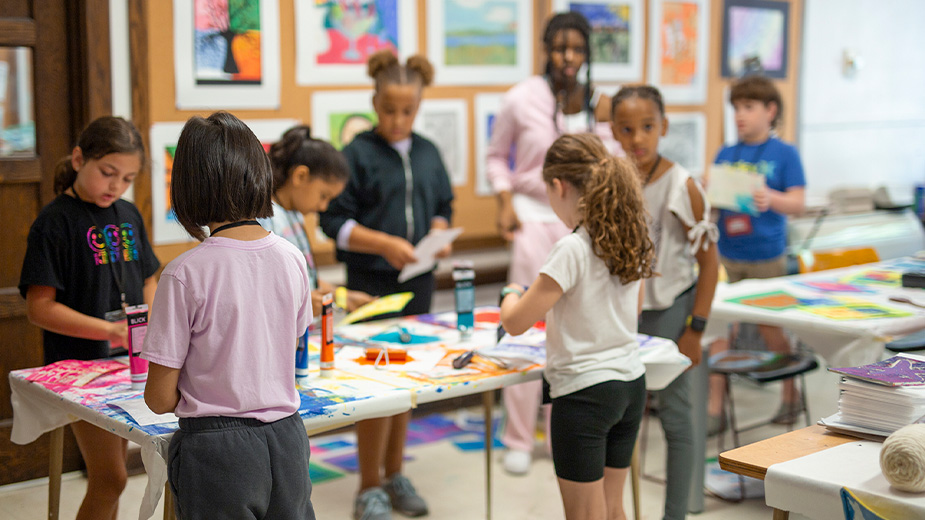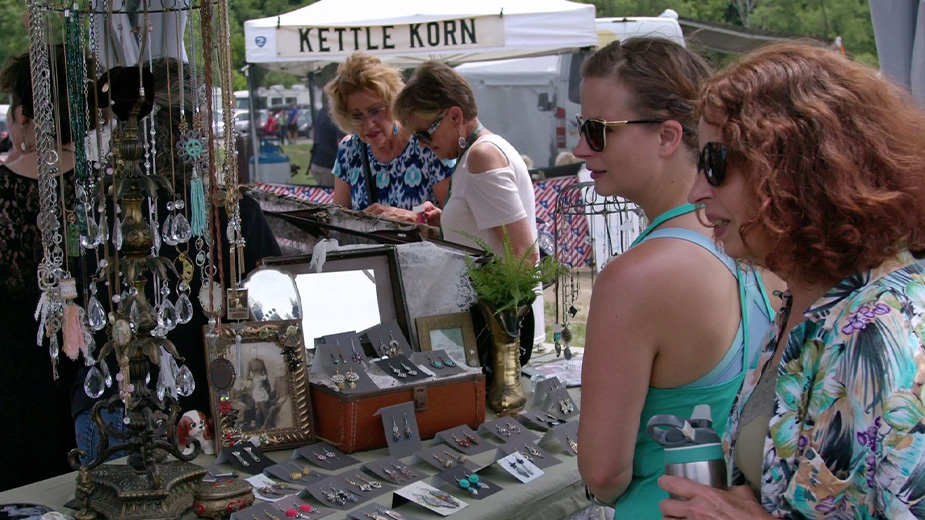Movie Props Museum in Warren Coming into Focus
WARREN, Ohio – Meghan Reed admits her favorite items in the collection of Hollywood props donated by John Zabrucky to the Trumbull County Historical Society are the ones from “Men in Black.”
These include four of the egg-shaped chairs featured in an early scene of the 1997 science fiction-action-comedy film starring Will Smith and Tommy Lee Jones.
Also included are the molds used to make the chairs, as well as some of the weapons and other hand-held props used in the film.
“That’s a movie I grew up with,” says Reed, the historical society’s executive director. “Those are pieces that I immediately recognized when I saw them. So that was exciting for me.”

The items from “Men in Black” are part of the collection that Zabrucky, a prop maker who grew up in Warren, donated to the historical society. The collection will form the basis of a museum in Warren. Although science fiction movie props represent the bulk of Zabrucky’s collection, several genres are represented.
“It took our team some time to get more familiar with the props and decide on a focus [for the museum]. After talking with science fiction fans and academics, we determined that fantasy was so closely related with the genre of ‘speculative fiction’ that it seemed hard not to include it,” Reed says. “We hope that adding fantasy and growing the collection in that direction will broaden the potential audience for the museum.”
The city of Warren recently approved providing $275,000 for TCHS to purchase a building on Main Avenue where the museum will be located.
In addition, Trumbull County Tourism has committed funds to assist the historical society with planning for the project.
“We believe in this project,” says Beth Kotwis Carmichael, executive director of the county tourism bureau. “We understand that having a solid business plan right out of the gate is important for a successful museum, and really anything that’s successful from our industry.”
The collection is stored at a location that isn’t being identified for security reasons.
So far, 10 truckloads of props have come to Warren, with another one or two truckloads anticipated.
The warehouse team at Zabrucky’s company, Modern Props Inc., is used to ship items to film and television production sets and they are packed extremely well. Very little was damaged in shipment, Reed says.
“It’s worth noting that there have been people that have called Modern Props “the Prada of prop companies,” she continues. “Because the props were rentals, they were created to last. They had to last.”
Crafted to last 30 to 40 years, many of the items, including some of the larger ones, are nearly 50 years old and still in good shape.
Tourist Destination
First and foremost, the museum is intended to be an economic driver for Warren and to promote tourism throughout the region, Reed says.
In planning for how the museum would operate and projecting how many visitors it might attract, officials are looking at the National Comedy Center in Jamestown, N.Y., as a model. Comparable to Warren in terms of demographics, Jamestown has a population of about 30,000, median income is about $20,0000 annually and the closest large city is Buffalo, about an hour and a half away.
“I don’t think any of us are under the assumption that we open this museum and boom, [get] 60,000 people a year,” Reed says. “But within the first three to five years, that’s really our goal. That’s what we want to hit.”
The museum will have two main audiences: diehard science fiction fans from across the country and families.
“In some ways, we also want it to be kind of a science center,” Reed says. “And we want to dive into thoughts and ideas of what science fiction is, and have hands-on interactives where we’re not just looking at what they thought the future looked like back in the 1970s or 1980s.”
Another concept is to look at what is being conceptualized now that might not be science fiction in 50 years.
Among the pieces in the collection is an item known as “the Most Important Device in the Universe,” a prop built in the 1970s that has appeared in more than 200 movies and TV shows. Among them are television series “Knight Rider” and “V,” the movie “The Last Starfighter” and the “Star Trek” TV and film franchises.
Some of the earliest pieces Zabrucky made have been recycled and used in multiple productions, including a “sonar-looking prop” created for the 1970s “Incredible Hulk” TV series and the mechanical recharging chair from “RoboCop.”
Hand props include weapons for “Star Trek” and “Blade Runner,” as well as the communicator that William Shatner’s Admiral James T. Kirk used in “Star Trek II: The Wrath of Khan.”
“Something we pulled up yesterday were prop guns,” says Beverly Nelson, science fiction and fantasy coordinator for TCHS. “Some of them are huge and oversized. And there are a couple that looked like they are real guns that were retrofitted into props.”
TCHS staff members are in the process of identifying the collection’s pieces. Among the hundreds of items in the warehouse is a prop weapon that Nelson identifies as “the Intimidator,” one of four she says the historical society has in the collection. A rental receipt found in the box containing it shows it was used in the TV series “Firefly” and the movie based on the short-lived Fox series, “Serenity.”
“This is one of the cool ones. I like this a lot,” Nelson says.
Beyond the more instantly recognizable pieces are collections of control panels and other futuristic lab equipment. Other larger pieces include a large globe sculpture from “Westworld” and what are believed to be a set of teleporter tubes.
“If you ever need a futuristic chair, we’ve got at least 10 different renditions of chairs,” Reed says.
Modern Props, especially early on, was “trying to envision what the future would look like – science fiction kind of at its core,” she says. The company was “tasked with creating an aesthetic” for whatever film or TV project it was working on.
“It was like world building. They were used to create the world that was the setting” for the movie or TV show, she adds.
“The most exciting part for me working with this collection is the moment of realizing what something is,” Nelson says. “We can pull props out of boxes or look at these huge panels with no idea what they’ve been in. But there’s nothing more thrilling than finding out what something is and where we may have seen it before.”
Collaborations
TCHS is in discussions with Oh Wow! The Roger & Gloria Jones Children’s Center to provide in-person programming focusing on science, technology, engineering and mathematics, Reed says.
Oh Wow is “really excited” about programming related to the science behind science fiction, including using the virtual reality classroom now being developed.
Much of science fiction just uses the roots of science and things that haven’t been discovered yet and expands those concepts into “something that can be possible,” says Marvin Logan, Oh Wow’s executive director.
One of Logan’s favorite examples is “Interstellar,” a movie that, even though it requires some suspension of disbelief, has “a lot of factual science,” he says. He also points to renowned astrophysicist Neil DeGrasse Tyson, who has postulated the weight of Thor’s hammer, Mjolnir, and the location of Krypton, Superman’s doomed homeworld.
“We’ve also talked about the science behind set making” and understanding how physics is involved in creating science fiction props, along with both practical and computer-generated effects, Logan says.
Reed envisions a target date of late 2024 or early 2025 to begin renovation of the existing building, which has about 18,000 square feet of usable space, and construction of a proposed expansion.
The goal is to have design drawings completed by early 2024 to be used in the fundraising campaign, which Reed admits is “going to be a bigger campaign than we’ve ever done.”
The goal is to raise enough money to do both the renovation and the building addition simultaneously. But if that objective isn’t achieved, the renovated space will be designed with future expansion in mind.
“We want something open within three years,” Reed says.
A fundraising campaign is expected to get under way in early 2024, Reed says.
Acquisition of the building ideally will be complete by the end of this year. The historical society expects to select an architectural firm in the next couple of months to provide “a more direct sense of how much an expansion will cost and how much we need to write into our campaign for that,” she says.
The Trumbull County Historical Society also is working with Exhibit Concepts, a national exhibit design firm, to do initial renderings to show the community what the space could look like and that can be used in the fundraising effort.
“Another one of the big things that we’re looking at now is strategically growing the collection,” Reed says.
Zabrucky’s vision was for his donation to serve as the museum’s “founding collection.”
But TCHS also is looking at expanding the collection with the help of local people who have been involved in projects related to the museum’s themes and also by acquiring materials at auction.
Zabrucky’s collection is strong from the late 1970s until the early 2000s. But there is “a lot of [science fiction and fantasy] stuff before and after that,” she says.
Reed and her existing and potential partners are optimistic about prospects for the new museum.
Niche museums such as the National Comedy Center and the Baseball Hall of Fame in Cooperstown, N.Y., to name two regional examples, are “undoubtedly assets to small towns,” says Melissa Phillips, executive director of Warren Redevelopment and Planning Corp.
“The sci-fi museum will not only attract tourists but the proposed STEM education components will provide a fun place for parents and kids to enjoy again and again,” Phillips says. “This museum will be an awesome contribution to the ever-growing amenities in downtown Warren.”
Younger people are definitely more interested in science fiction than they were years ago, says Carmichael, the county tourism chief.
Reed shares that sentiment. Older fans she has spoken with have noted science fiction wasn’t the cool thing to be interested in but today is more mainstream.
“It’s been much more just accepted into popular culture,” she says. “We’re opening this museum at the right time in cultural history.”
Pictured at top: Meghan Reed and Beverly Nelson say most of the movie props were used in science fiction and fantasy films.
Copyright 2024 The Business Journal, Youngstown, Ohio.



